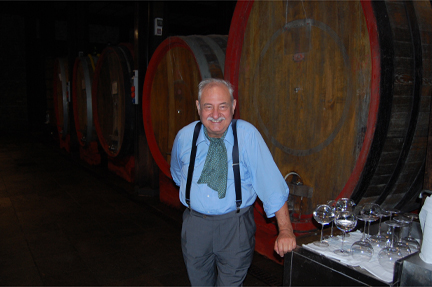
Above: Gianfranco Soldera, legendary, enigmatic, and paradigmatic winemaker, a Trevisan farmer turned Milanese industrialist turned Montalcinese winemaker.
Anyone who’s ever had the good fortune to be invited to visit Gianfranco Soldera’s estate, Case Basse, in the southwestern subzone of the Brunello appellation will surely share my impression that his winery, vineyards, and contiguous botanical garden come together to form what is undeniably one of the most impressive estates in the world.
When he began looking for an estate to purchase in the early 1970s, the Piedmontese wouldn’t sell him a decent plot of land, he told me the other day when we visited. So he decided to to buy a parcel in Montalcino on the advice of a friend who had told him you could pick up a piece of land there for a boccon di pan, a mouthful of bread, in those days.
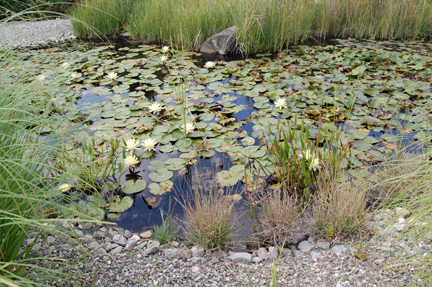
Above: The botanical gardens at Soldera’s Case Basse include a swamp (to create a maritime influence) and a white flower garden (to encourage nighttime pollination). “Ah, the white flower garden,” remembered wistfully my friend Dr. Lawrence O, the other day when he spied my visit on Facebook. Lawrence has visited there, of course.
When you talk to winemakers in Langa (Piedmont), many of the current generation still look to Soldera as a doktorvater (like Beppe Rinaldi, who told me that he often seeks advice and guidance from Soldera when the elder visits Barolo).
In many ways, it’s as if Soldera, when faced with the fact that he couldn’t make wine in Piedmont where he so obstinately desired to do so, decided to construct his own microclimate within the Brunello macroclimate. As he explains very openly, the remarkable botanical garden on his property (manicured by his wife) creates a unique ecological balance of plant and swamp life, including the “white flower garden,” so famous among wine insiders, intended to encourage pollination at night because the bright peddles attract the insects in darkness.
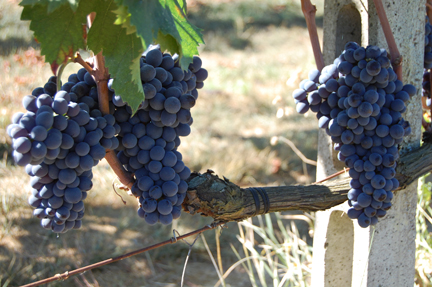
Above: “You find no vineyards with larger berries nor smaller clusters,” said Soldera proudly of his fruit. The attention to detail in his vineyard management is truly stunning.
Soldera has famously stated that he makes “natural wine.” Whether or not that’s the case is something I’ll leave that to the experts in the thorny field. He does seem to meet all the card-carrying members’s requirements: manual vineyard management, no chemicals in the vineyards, ambient yeasts in the cellar, no temperature control, lowest possible sulfuring. While I was in his presence a few weeks ago, he scolded one very famous winemaker in absentia for using cement vats for vinification, noting that wood is the natural vessel for winemaking. He also scolded another very famous winemaker for suggesting that it was okay to use a starter yeast when he had trouble initiating fermentation in his cellar.
But is it natural, I wonder, to build a botanical garden using mountains of manure (however organically prepared) in a place abandoned by sharecroppers because nothing would grow there anymore? I’ve leave that one to the exegetic forces of the rebbes and erstwhile Talmudic scholars in our field.
One thing we can all seem to agree on is that his wines are among the best in the world (and accordingly priced). I had the good fortune to taste the 2008 (extremely good) and 2006 (exceptional vintage, one of the best I’ve ever tasted) out of cask with him in the cellar. And at dinner we drank the 2003: an infamously and remarkably difficult vintage for any winemaker in Italy yet a harvest for which Soldera delivered lip-smacking acidity and gorgeously nuanced fruit aromas and flavors in his Sangiovese. These wines are simply life-changing, mind-blowing, awe-inspiring… It’s true…

Above: Soldera with Roberto Rossi, chef/owner of Il Silene, arguably the best restaurant in southern Tuscany. The drive up to Seggiano is worth it if only to taste Roberto’s olive oil. The food and service were amazing.
Anyone who’s ever had the good fortune to be invited to visit Gianfranco Soldera’s estate, Case Basse, will tell you that Soldera keeps no secrets and he liberally shares his often salty opinions with those whom have been invited for an audience. (You’ll be surprised to find out that he has a website.)
Our conversation spanned many generations of Italian winemaking the other day when I visited him and you can imagine the controversial topics we covered. But the thing that stuck with me was what he said when I asked him what he saw for the future of winemaking in Italy.
“Commercial winemaking has come to an end in Italy,” he said referring to the recent Brunello controversy and rumors that the historic Barbi estate has plans to sell its property to Italian wine behemoth Zonin. “The nature of Italy cannot support industrial farming and commercial winemaking has run its course historically,” he told me. However many grains of salt there may be in the world according to Soldera, there’s certainly a grain of truth in this morsel of wisdom.
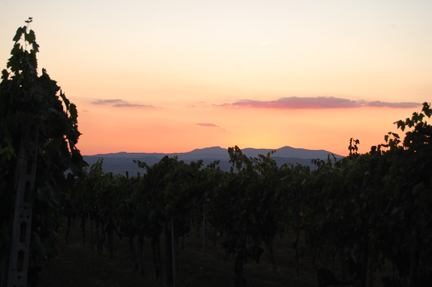
Above: Sunset at the Case Basse estate.
Another winemaker told me the same thing later on in my trip. Stay tuned to find out which one…

 As much as I despise the editors of The New York Post, I couldn’t help but laugh out loud when, over a straphanger’s shoulder, I read my favorite example of yellow journalism back in 1999:
As much as I despise the editors of The New York Post, I couldn’t help but laugh out loud when, over a straphanger’s shoulder, I read my favorite example of yellow journalism back in 1999: 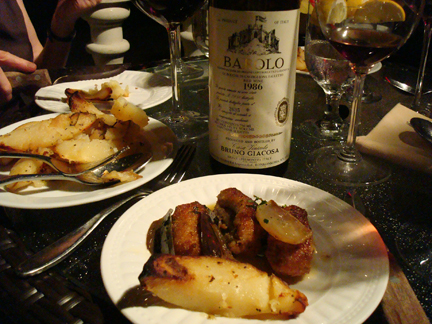
 My friend Lawrence Osborne gave me a shout out in the current issue of Men’s Vogue (June/July 2008), in an article about a wine that means a lot to me: Lini Lambrusco. I can’t say that I mind being called “a wine connoisseur and Italian scholar extraordinaire” by the Accidental Connoisseur himself.
My friend Lawrence Osborne gave me a shout out in the current issue of Men’s Vogue (June/July 2008), in an article about a wine that means a lot to me: Lini Lambrusco. I can’t say that I mind being called “a wine connoisseur and Italian scholar extraordinaire” by the Accidental Connoisseur himself.  I also made an appearance in the Spring issue of Gastronomica with a piece on the history of pasta, Risorgimento Italy, and pasta’s role in the Italian national identity.
I also made an appearance in the Spring issue of Gastronomica with a piece on the history of pasta, Risorgimento Italy, and pasta’s role in the Italian national identity.